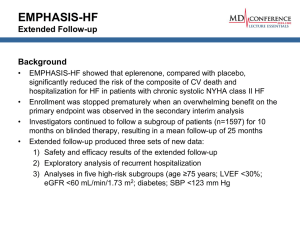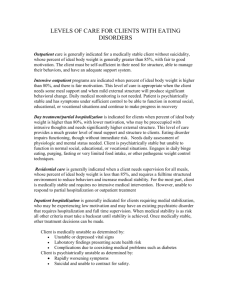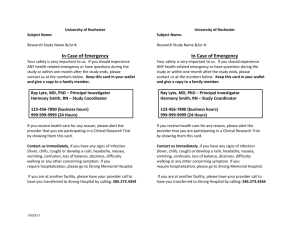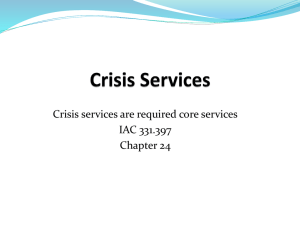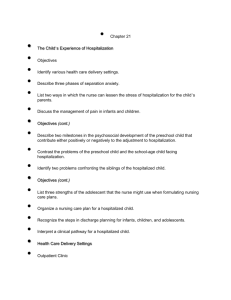Long-term Hospitalization and the Impact on Emotional Well
advertisement
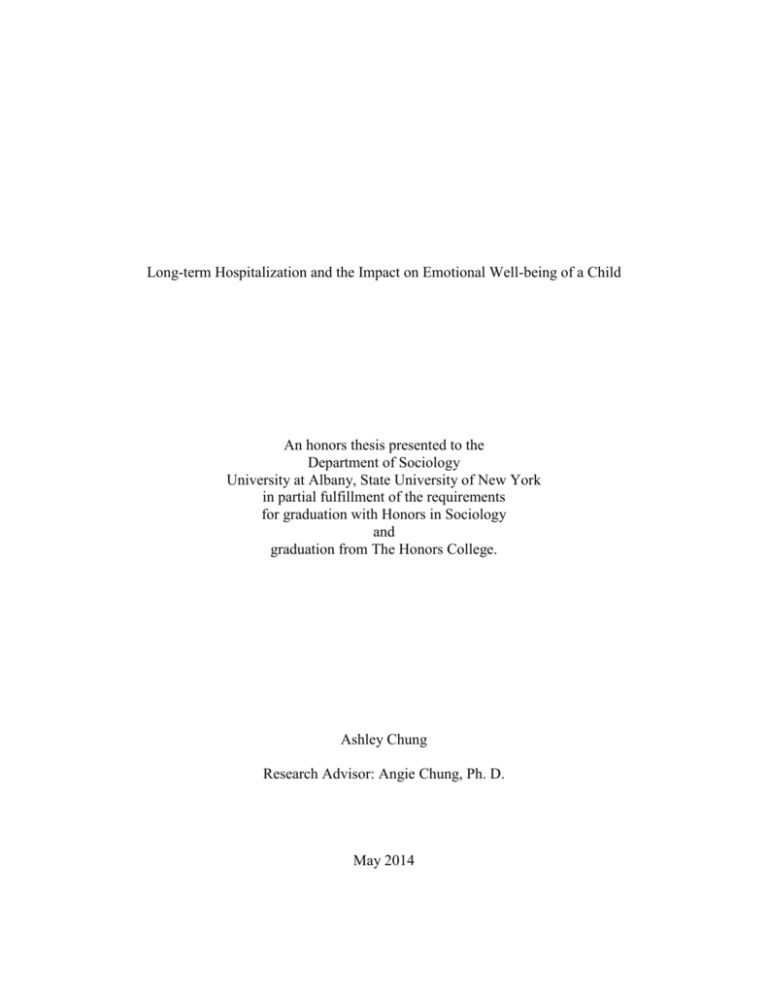
Long-term Hospitalization and the Impact on Emotional Well-being of a Child An honors thesis presented to the Department of Sociology University at Albany, State University of New York in partial fulfillment of the requirements for graduation with Honors in Sociology and graduation from The Honors College. Ashley Chung Research Advisor: Angie Chung, Ph. D. May 2014 Abstract The question I attempt to answer with my research is: How does long-term hospitalization impact the emotional well-being of a child? I am measuring the impact on development and emotional state that hospitalization has on an individual that is still in the process of determining their self-identity, while also identifying the consequences of childhood illness. A necessary emphasis is placed on the vulnerability created by long-term hospitalization and the separation from home; a focus on the feelings of isolation and loss of security created by loved ones is essential in understanding the role that family plays in the hospitalization of a child. Also, I am trying to understand the impact that various aspects of inequality have on how a child that is hospitalized over a long period of time adjusts to their period of hospitalization. The methodology for this thesis mostly involves secondary data analysis where I gather data previously conducted by research on the same and similar topics in addition to an interview with an individual that was hospitalized during adolescence to act as a supplement to the secondary data I collected. 2 Acknowledgements I would like to offer a special thanks to Professor Angie Chung and Professor David Wagner for assisting me in the writing of this thesis project and providing me with the necessary constructive criticism that I needed in order to successfully complete the research and development involved with composing this project. I would also like to thank the Sociology department faculty and staff members for providing me with the resources and opportunities that made the completion of this project a possibility. Additionally, I would like to extend my gratitude to Professor Jeffrey Haugaard and the University at Albany Honors College for presenting me with the opportunity to explore different subject matter through intriguing and challenging courses, as well as providing me with guidance whenever I needed help. Last but not least, I would like to acknowledge the support provided by my family and friends throughout my entire undergraduate career. The financial, emotional, and moral support made it possible for me to prosper during my years at the University at Albany and allowed me to recognize all the opportunities available to me both inside and outside the university. 3 Table of Contents Abstract 2 Acknowledgements 3 Part One I. Introduction 5 II. Major Stressors of Long-term Hospitalization 8 III. Effect of Stressors 9 IV. Coping with Hospitalization 10 V. Role of the Family 11 VI. Literature Review Conclusion 12 I. Hypothesis 13 II. Development of Research 13 III. Predictions 15 IV. Timeline 15 I. Results 16 II. Interpretations 27 III. Glimpses Beyond 28 Part Two Part Three References 30 4 Part One I. Introduction The focus of my research pertains to the question: How does long-term hospitalization impact the emotional well-being of a child? To properly explore this topic I created definitions for the terms in order to further clarify the objective of my research. To understand my meaning of long-term hospitalization, I define it as an extended period of time that begins when an individual suffering from a severe illness becomes aware of the isolation from loved ones due to their residence in a hospital or other facility. This definition explains that long-term hospitalization is not defined by a specific amount of time, but by the moment an individual identifies their isolated situation. Emotional well-being can be described as the mental health of an individual that is judged by self-reported or care-taker reported happiness, physical activity, amount of positivity, and visible energy. Similar to my definition of long-term hospitalization in the way that there is not a set time frame, is my definition of a child. I do not define the term child by a numerical age range; instead, my definition is based on the “social age” of an individual—a developmentally determined age that classifies an individual as a child. The explanation of the social age that I intend to use to conduct my research can be described as an individual that is still in the process of determining their self-identity while also being emotionally and physically dependent on family and loved ones. Geist et al. (2003) states that “chronic disease affects an estimated 10-20% of all children during childhood and adolescence.” Luckily, advances in medicine in recent years, have increased the likelihood of surviving childhood illness and decreased the mortality rate. 5 However, as survivors of illness during childhood, these individuals not only have to deal with “normal developmental stressors” but they are also attempting to manage the impact that longterm hospitalization can have which can possibly result in long lasting, detrimental effects (Boyd and Hunsberger, 1998). A. Vulnerability of the Child Compared to adults, young children are significantly influenced by hospitalization and its associated factors. They are obviously not as emotional or cognitively developed as an adult and often lack proper comprehension, communication and verbal expression skills that are necessary to convey their needs, emotions, and experiences. As a result, their feelings and anxiety levels tend to go unnoticed by caretakers and loved ones (Boyd and Hunsberger, 1998). For all individuals, once they are admitted into a hospital they are stripped of their personal belongings, they must be dressed in a revealing one size fits all garment, poked and prodded by unfamiliar people, and lose almost all aspects of personal space. Being thrown into such an unfamiliar environment is unsettling for most adults, and even worse for most children. And when comparing newborns to adolescents, hospitalization has varying long-term developmental effects (Larsen, 1961). Between ages one through five, hospitalized children tend to go through stages of separation anxiety from parents and loved ones. Children that are under the age of three are the most vulnerable to the possible effects of prolonged hospitalization due to diagnosis of a severe illness than older children are. Their increased susceptibility is based on Freud’s theories of psychosexual development. For a three year old child, “separation from the mother...[is] 6 often misinterpreted as punishment or desertion, [and] appears to pose the chief threat to a still immature and dependent ego,” (Prugh et al., 1953). As the stages of separation anxiety progress, not only does a child tend to “regress” but they will also have a difficult time re-adjusting back to their previous life (Freiberg, 1972). B. How Children View Illness As children mature, their thinking in regards to illness and disease start to become similar to the adults that surround them. But initially, research suggests that parental ideas about illness do not match the ideas held by the child. According to research performed by Koopman, et al. (2004), children view illness in phases based on Piaget’s model. These stages are labeled as the “invisible” phase, the “distance” phase, the “proximity” phase, the “contact” phase, and the “internalization” phase. The invisible phase explains that children do not consider the “What? Why?...How? aspects of illness.” Children in this stage tend to create associations rather than understanding the major characteristics of a chronic condition. The distance phase is defined by Koopman as a stage where children are unable to draw a connection between the body and illness. The third stage, proximity, is when children understand illness as related to their immediate surroundings and that falling ill is a result of “contamination by nearness.” The contact phase is characterized by a widening definition of disease and an increased comprehension of the causes of disease. However, at the contact stage children are still unable to differentiate between the roles that the mind and body can play in illness, but there is an understanding about that medicine can cure illness. Lastly, the internalization stage is described as the development of a basic awareness that the cause of a disorder 7 can be found in the body, and the cause for illness can be due to external factors or health-affecting behaviors. There is also a more solid understanding that medicine cures illness and the realization of the role that is played when getting cured from or preventing a disease (Koopman, et al., 2004). II. Major Stressors of Long-Term Hospitalization Based on data collected by McCaffrey (2006), Roberts (1972), and Boyd and Hunsberger (1998), I was able to compile a list of major stressors associated with childhood long-term hospitalization. This list includes, but is not limited to: procedures, needles, infections, loss of control, long hospital stays, relapses, fear of dying, other children dying, check-up results, separation from friends, lack of independence, hospital environment, lack of activities, and restriction of movement. Chemotherapy, medical tests, invasive surgeries, and other associated procedures cause a constant fluctuation of a child’s stress levels because of the possibility of negative results or outcomes. Also, young children often lack proper comprehension to fully understand majority of the procedures—such as confusing being placed under amnesia, or “being put to sleep” as death—leading to increased anxiety in a child (Roberts, 1972). The death of other children in a similar medical situation also exacerbates stress levels in a hospitalized child because it is not only the death of a friend, but a reminder of a possible fate. Illness is often erratic, varying from day-to-day resulting in no consistency for the child as well as causing them to feel less in control of their situation. Additionally the noise levels of a hospital, the stripping of personal belongings, and the lack of privacy, are all new and often unsettling for any patient admitted into a hospital (Larsen, 1961). Lastly, Piaget indicates that young children tend to associate 8 restriction of movement with death and older children associate it with the loss of peer interaction and as a separation from everyday living processes. The combination of these feelings and feelings of boredom due to a lack of possible activities can also cause spikes in anxiety and stress levels (Roberts, 1972). III. Effect of Stressors The major stressors identified by McCaffrey, Roberts, and Boyd and Hunsberger tend to have ongoing effects for children that are hospitalized from long periods of time. After reading numerous articles, I was able to conclude that low self-esteem and body image issues are a major consequence of childhood hospitalization. Harassment and ignorance from school teachers and peers often lead to feelings of embarrassment and feeling ashamed of their condition. It is often the case that children that are admitted into a hospital for extended period of time get so accustomed to life in a hospital that they are unprepared for the transition back into “normalcy” once they are removed from the hospital setting (McCaffrey, 2006). Also contributing to low self-esteem and poor body image is the inability to keep up in school because of feeling “left behind.” Serious illness and long-term hospitalization makes it difficult for children to keep with school work and community events (Geist et al., 2003). Isolation and emotional regression are also serious consequences of childhood illness. After the diagnosis and treatment of a severe illness or disorder, children often tend to mature faster than their friends. At school, it is difficult for them to find peers to relate too and their condition often limits them from joining and participating in school sports and activities— leading to withdrawal, loneliness, and emotional seclusion (McCaffrey, 2006). 9 Due to the factors that cause isolation and poor body image, children that are diagnosed with a severe illness at a young age tend to develop depressive and anxiety disorders. The research conducted by Curtis and Luby (2008) was able to conclude that, “as many as 4% to 14% of school-aged children exhibit depressive symptoms within three months after the diagnosis of a medical illness.” Asocial behavior and depressive symptoms—such as sadness, irritability, whining, crying, and self-blame—as a result of rejection and bullying has been observed in patients as young as three years old (Curtis and Luby, 2008). Depression and anxiety can lead to a deterioration of a child’s physical condition (Geist et al., 2003) and sometimes a dependence on drugs (McCaffrey, 2006). It also worsens peer interaction and school performance. IV. Coping with Hospitalization Exploring coping methods for hospitalization is essential for children to properly adjust to an extended hospital stay. Children handle these stressors in and out of the hospital by keeping busy with hobbies and activities, and exercise. If possible, while in the hospital it is helpful for children to draw similarities to life at home, and distract themselves by using personal comforts to temporarily mask their illness (McCaffrey, 2006). Independent activities and blatant avoidance have also been observed in hospitalized children as a way to momentarily escape the stressors associated with their illness (Boyd and Hunsberger, 1998). Similarly, Boyd and Hunsberger (1998) found that social support and physical support from family and friends has helped hospitalized children cope with illness. Finding peers to relate to and a setting that allows for proper expression of the emotions felt after and during the diagnosis and treatment of an illness or a disorder is beneficial in dealing with the stressors of illness. Secondly, children in the hospital tend to respond better to their circumstances when 10 they are given or seek information about their condition they’ve been diagnosed with and the treatment process involved. If there is an increase in awareness about their situation they are more likely to feel more comfortable about their position. V. Role of the Family The role that the family plays in long-term hospitalization of a child influences the stressors that hospitalized children experience, the effect of these stressors, and the coping process of the child. Roberts (1972) research asserts that “the child’s interaction within his family has more influence upon his subsequent development than any other experiences.” Diagnosis of a child with a life-threatening illness completely alters the family dynamic and places family into a “crisis situation,” (McCubbin et al., 2002). It is essential that parents treat an ill child as simply a member of the family—rather than the center of attention—and maintain normalcy. Feelings of guilt and frustration tend to cause parents to overcompensate and attempt to give the child everything that they want (Roberts, 1972). It is important for parents to remember that although their child has been diagnosed with an illness, they are still a child and still need boundaries. Following similar routines with parents not only makes hospitalized children generally happier and more pleasant, it allows for an easier transition back into their normal routine upon release from the hospital. Parents are necessary to strengthen feelings of security with home ties that hospitalized children need. Without consistent parental involvement hospitalized children tend to feel less positive about their situation and are often “emotionally unhealthy” (Wallace and Feinauer, 1948). Extended family also plays an important role in the hospitalization of a child. Any additional support and assistance for a hospitalized child and their immediate family is 11 advantageous. Members of the extended family often fill the gaps that parents leave while trying their best to take care of a hospitalized child. Most parents that have children in a hospital have full-time jobs and need to keep working in order to support their family and can’t always be there for their child—which is where extended family tends to fill-in. Also, in the cases where the hospitalized child is not an only child, it gets difficult for parents to maintain home and provide support to both their hospitalized child and non-hospitalized children (McCubbin et al., 2002). It has been shown that siblings of hospitalized children are often negatively affected by the illness or hospitalization of their sibling—however assistance from extended family could help lessen the impact (Roberts, 1972). VI. Literature Review Conclusion Based on the literature that I found on the topic of childhood hospitalization, I am able to conclude that the impact that long-term hospitalization has on a child is fairly negative and has the same overall impact on all hospitalized children. However, gaps in my research left me questioning if social inequality has any impact or effect on childhood illness. Current literature has a significant amount of information that describes the general effects of long-term hospitalization with little mention of any possible effects that aspects of social inequality could have on childhood illness and hospitalization. Hopefully the data I collect as well as further secondary data analysis will close this research gap and provide the answers to this question. 12 Part Two I. Hypothesis Before conducting my research, I hypothesized that in addition to the overall general impact of long-term hospitalization on children identified by current research, childhood hospitalization is additionally impacted by aspects of social inequality. I have identified my independent variable as long-term hospitalization and my dependent variable as features of social inequality—such as age, gender, and race or ethnicity. After my research is completed I hope to find accurate evidence that either supports or renounces my proposed theory. II. Development of Research In order to develop informed data that will allow me to accurately determine the impact that long-term hospitalization has on children I intend to conduct my research through the use of a guided interview with one participant. Initially, I had intended on conducting interviews at either Albany Medical Center or St. Peter’s hospital because of their close proximity to my location as well as the fact that they both have pediatric care units; but current privacy laws do not allow me to enter a hospital to question current patients and staff members regarding privileged information. Therefore, instead of entering a hospital to find individuals willing to participate in my research, I decided to try to locate a participant through friend and family networks who was hospitalized during adolescence for a period of time that was long enough for the individual to begin to experience feelings of isolation and loss of security from family and loved ones as a result of being hospitalized. I was able to get in contact with one individual who fit this criteria and I then conducted an hour long guided interview with this participant. 13 The individual that I interviewed is currently a twenty-one year old male of Hispanic descent who was hospitalized at the age of 15 with a severe case of Lupus. We communicated through an online video call and I was able to ask him specific questions concerning his experience in the hospital and learn facts about his medical circumstance; additionally, I was also able to inquire about his support system, his emotional condition while in the hospital, and lastly, question him regarding aspects of inequality that might have indirectly or overtly resulted in a difference of treatment and care by medical staff or a difference in emotional state compared to other patients in the hospital. The focus of my research surrounds the questions: How vulnerable is a hospitalized child? What are the main stressors of long-term hospitalization that affect the emotional wellbeing of a child? What are the factors associated with long-term hospitalization? What is the impact of the stressors (positive or negative) caused by long-term hospitalization on the emotional well-being of the child? How do children cope with the stressors that are associated with long-term hospitalization (in and out of the hospital)? How large of an influence does the role of the family have on stressors, the effect of stressors, and the coping process? How does the role of the family affect the hospitalization process? How does a child’s age, gender, or race and ethnicity impact emotional condition and period of hospitalization? In addition to collecting data through the use of a guided interview I will continue to exploit my research resources at the libraries on campus by constantly searching databases for literature I might have overlooked as well as staying updated on current literature about the topic of childhood illness and hospitalization. Staying informed of existing literature not only provides a strong starting point for my research but also acts as a form of support and clarification for the assertions and data I develop as I conduct my own research. 14 III. Predictions I predicted that after evaluating the data that I gathered from my research study, I will find that aspects of inequality further impact the emotional well-being of a child that is hospitalized for an extended period of time. The existing research that I analyzed provides an extensive amount of research surrounding several aspects of long-term hospitalization and childhood illness that it is inevitable for my own research to come to similar conclusions. Alternatively, I predict that through my guided interview I could possibly uncover new negative effects and major stressors of illness and hospitalization that have not been acknowledged in present literature. Also, I forecast that my research will discover several positive impacts of long-term hospitalization as well as allow me to develop a better understanding of the role that family plays in childhood illness and long-term hospitalization. IV. Timeline The development and analysis of my research took almost the entire spring 2014 semester to properly and thoroughly complete. I used the month of January 2014 to prepare and specify the methodology and research strategy that was best suitable for this study. Upon determining exactly how I would conduct my research, I used the months of February 2014 and March 2014 to research and gather my data through the use of secondary data analysis and a guided interview. Once all of the data was collected and organized, I used the month of April 2014 to analyze my data and propose conclusions based on the information that was presented by the data derived from the study. After collecting and analyzing all the data I accumulated, I used the remaining time to neatly compose a final thesis. 15 Part Three I. Results A. Hospital Experience According to Skipper and Leonard, “much of a child’s behavior while hospitalized...is presumed to be a response to psychological and physiological stress.” This stress could be attributed to many factors as mentioned earlier. A list of the stressors identified by hospitalized children include, but are not limited to: procedures, needles, infections, loss of control, long hospital stays, relapses, fear of dying, other children dying, check-up results, separation from friends, lack of independence, hospital environment, lack of activities, and restriction of movement. The major stressors identified by the participant that I interviewed parallel this list. He described his medical procedures as his primary stressor; procedures such as chemotherapy led to other physiological complications that he identified as “his most traumatic experience during his entire period of hospitalization.” He went on to define other sources of his stress which included the difficulty he faced when trying to accomplish tasks that he was no longer able to do on his own. He stated that he was unable to move, walk, eat, or drink, and the stress of not being able to perform daily life functions put him in a position where he was easily angered and constantly frustrated. After the participant identified the aspects of his period of hospitalization that were the most traumatic and the most stressful, I followed up with the questions, “How do you think this period of hospitalization has impacted your life—positive or negative?” 16 and “How do you think you have changed as a person as a result of being hospitalized for an extended period of time?” He responded with no negative remarks. Typically, effects of the stressors of childhood hospitalization have been identified as negative peer attention, declining self-esteem, lack of acceptance and understanding when re-entering school by teachers, faculty, and students, adverse side effects to medicine and treatment after being discharged from the hospital, more mature than friends, emotional regression, physical disability, and inability to continue with majority of the hobbies and activities enjoyed prior to diagnosis (McCaffrey, 2006). However, the participant refused to identify any negative outcomes that may have resulted from his period of hospitalization. Instead, as he began to better comprehend his situation, he regarded his period of time spent in the hospital as a learning experience rather than an undesirable life event. He expounded on his view point by saying, “I became more appreciative of life; my time in the hospital has had a positive impact on me because it forced me to learn to appreciate the things that most people take for granted...It motivated me to become a better person because we never know how much time we have. My values changed and now I try to be less selfish and more thoughtful of others.” Usually, emotions following an extended period of hospitalization resemble feelings of depression, loneliness, and social rejection—even for young, pre-school age children (Curtis and Luby, 2008). This is often a result of the vulnerability of children; as well as a lack of appropriate communication and verbal skills needed to properly convey the range of emotions and attitudes they are experiencing as they face the highs and lows associated with childhood illness and hospitalization. It is believed that school-aged children, compared to younger children are better able to cope with the stress that 17 accompanies illness because they have a more advanced “ability to reason, comprehend verbal explanations, communicate needs, express feelings about their experience and tolerate separation of family,” (Boyd and Hunsberger, 1998). However, although older children tend to have more of the necessary communication skills than younger children do, these children are still very hesitant to express their sentiments and needs due to the strangeness of their current circumstances. When asked, “Were there any members of the hospital staff that you were able to develop a personal relationship with?” and “Were you able to express personal attitudes and feelings with him or her?” the individual that I interviewed responded by explaining that he developed an unusually close relationship with a janitor. The participant described the janitor as an individual who helped him through his period of hospitalization simply by visiting the participants’ room and holding meaningful conversation. The participant regarded the janitor as an ally in the hospital but stated that he was nonetheless still uncomfortable expressing personal feelings and attitudes with him. In fact, the participant went on to mention that he wasn’t able to express any type of emotions or feelings with doctors or nurses either—unless he felt it directly affected his medical circumstance. When relationships are established between a hospitalized child and the hospital staff or medical team that is responsible for their care, stress attributed to illness and long-term hospitalization can be lessened (Prugh et al., 1953). During a child’s period of hospitalization, members of the hospital should be able to “prevent and alleviate emotional stress [while also making] the hospital experience a vital learning situation for the child and his family” (Wallace, 1948). When the participant that I interviewed for this research study was asked, “Can you explain your relationship with the hospital staff 18 members?” and “Was there anyone in specific that improved your hospital experience?” he responded by stating that his primary doctor and one of his nurses, specifically, positively impacted his time at the hospital. He explained that, “majority of the staff members did what they could to create a warm environment, they were loving, friendly, and always smiling. They improved my hospitalization experience simply by creating a favorable environment.” B. Support System Admittance into a hospital often induces severe feelings of isolation as a consequence of the individual having to separate themselves from family and loved ones while also adjusting to a drastic change in lifestyle. Once a child is admitted into a hospital they are forced to relinquish majority of their personal items and quickly assimilate themselves into the hospital environment. If an ill child is poorly adjusted to the hospital setting “emotional conflict” is inevitable and can cause serious harm to the child’s state of mind. Feelings of security with home ties need to be established in order to lessen the negative outcomes associated with childhood hospitalization (Wallace, 1948). Behavior of a hospitalized child during their stay at a hospital and even after their discharge is often a reflection of the “attitudes and anxieties of the parents.” This transference of parental emotions over to the child can also impact familial interactions following the child’s period of hospitalization. Parental unease can “set off reverberations in the emotional climate of the family group” and contribute to negative outcomes after a child is released from the hospital and is attempting to readjust back into 19 his or her life prior to diagnosis. The noticeable offset created by the parents’ emotional response to their child’s illness can result in the child’s inability or difficulty obtaining “normalcy” (McCaffrey, 2006) once the child makes an effort to return to their previous life after coming back from the hospital (Prugh et al., 1953). Specifically, the mother or motherly figure of a hospitalized child can significantly influence their child’s emotional condition. Mothers can radically improve a child’s emotional status or can be severely detrimental to the child’s already fragile condition. If the child’s mother is exhibiting feelings of extreme stress those feelings of anxiety can be unintentionally, or intentionally, transferred to the child and drastically worsen the well-being of the child. On the other hand, if a child’s mother is able to maintain a calm and contained demeanor her child will feel significantly more at ease and the emotional stress a child is experiencing will be reduced (Skipper and Leonard, 1968). With the large role that family—specifically mothers, plays on the emotional well-being of hospitalized children, most hospitals encourage mothers to take on a notable amount of the care involved with nurturing a severely ill child back to health (Prugh et al., 1953). During the interview with the individual that agreed to participate in this research study, I asked a series of questions in order to estimate the functionality of his support system. Some of the questions asked include: Other than hospital staff, who took care of you? How did they take care of you? What did they do to take care of you? How much time did you spend alone? When you weren’t alone who did you spend your rime with? Did your visitors consist of mostly friends, or mostly family members? How did you feel when your friends or family came to visit you? Did you notice a change in mood when you had visitors compared to when you didn’t have visitors? If you were 20 able to share your fears and concerns with anyone, who were you able to share them with? Aforementioned assertions describing the essential role of the mother on emotional condition of the child, and the responsibility of the mother to fulfill the position as primary caretaker are supported by the participants’ responses to the questions that I used to determine where majority of his support resonated from. The participant illustrated that his main supporter during his period of hospitalization was his mother. He explained that although it was “hard for [him] as a man, to let [his] mother see him in that state...” she was his primary caregiver and most of the time that he spent at the hospital, his mother was there. Because there were periods of time where the participant could barely move or do things for himself, his mother took the responsibility of showering him and helping him use the bathroom. Although there were nurses and other hospital employees that were capable of performing these tasks, the participant’s mother had decided to take on a majority of the aspects revolving around her son’s care herself. The participant reported that when he had visitors, whether it was friends or family, it allowed him to temporarily forget about his current situation. He explained that although he was left alone in his hospital room for less than an hour per day, when he was alone and confined to a hospital bed, all he did was think about sickness and his current predicament. The participant mentioned that compared to when he had friends and family visiting his hospital room, as opposed to having no visitors, he recognized a noticeable change in attitude. The presence of his friends and family brought laughter and joy to his not so joyous circumstances. 21 C. Inequality 1. Gender No two children will have the same exact hospitalization experience; therefore, all children that are hospitalized as a result of a serious illness will not respond in the exact same manner to their period of hospitalization. However, certain internalizing responses, externalizing reactions, and behaviors following discharge from the hospital have been noted and can be attributed to differences in gender. In an article written for the Journal for Specialists in Pediatric Nursing, Small, Melnyk, and Sidora-Arcoleo, presented research and data expounding on the gender dissimilarities and consistencies identified in the emotional responses of hospitalized children. In order to identify behavior differences, Small et al. gathered data focusing on specific behaviors they defined as internalizing, externalizing, and post hospital behaviors. Externalizing behaviors include argues when denied own way, hits other children, talks back to parents, orders other around, bullies other, interrupts parents when they are talking on the phone, screams, blames others, and touching everything when shopping. Internalizing behaviors were described as worries about things that cannot be changed, worries, complains of pain, is afraid of dying, is nervous, says “I’m afraid I will make a mistake,” says “It’s all my fault,” says “I want to die,” and complains about health. Overall, the outcomes of Small, Melnyk, and Sidora-Arcoleo’s study asserted that there are significant differences in the emotional impact and responses as a consequence of long-term hospitalization between boys and girls. Their results suggest that boys tend to exhibit more of the externalizing behaviors than girls do, however the externalizing 22 behaviors that females did demonstrate seemed to start later and persist for an extended period of time whereas the boys’ behaviors peaked earlier and declined in a shorter amount of time. Also, generally speaking, the girls in the study did display more anxiety and nervousness—internalizing behaviors—than the boys. This data attests to the conclusion that “gender-specific behavioral patterns” do exist—in responding to the stress of long-term hospitalization, boys respond more with externalizing behaviors and females demonstrate more internalizing behaviors (Small et al., 2009). After analyzing Small, Melynk, and Sidora-Arcoleo’s research I was able to identify that the individual that participated in my research did display some externalizing behaviors as a result of his confinement to a hospital bed. He stated “one my preferred methods of stress relief was breaking things; I felt like I didn’t have control over very many things that were happening in my life and breaking things allowed me to temporarily feel in control.” Breaking and destroying items in his reach was the only specific behavior or action the participant mentioned in the interview—he did not describe feelings of anxiety, nervousness or constant complaints, or any other internalizing behaviors. 2. Age Particularly for this thesis project, I refused to set age parameters in order to define my meaning of the word “child” and who qualifies as a child. Rather, I defined child in terms of social age, or a developmentally determined age. The social age that I placed the focus of my research around is explained as an age where the individual is still in the process of determining their self-identity while also being emotionally and 23 physically dependent on loved ones. However, that doesn’t mean that all individuals placed within this social age respond in the same manner to an extended period of hospitalization. Hospitalized children at various ages are impacted differently by childhood illness and hospitalization. Children under the age of seven tend to endure more “frequent and lasting emotional and behavioral difficulties” as a result of childhood illness and hospitalization for the reason that specific stressors—separation from family and loved ones, introduction into an unfamiliar environment, constant forced communication with strangers, and medical procedures—have a more significant impact on younger children (Small et al., 2009). However, self-reported data suggests that younger individuals, defined as between the ages of six and thirteen, are more likely to report a better quality of life than older individuals, defined as between the ages of 14-18. Research suggests that this difference in self-reported data is explained by the inability of younger children to fully comprehend the reality of their situation. Older children, on the other hand, are more aware of their situation and as result tend to have lower self-esteem and are more influenced by the “treatment burden” (Hagarty et al., 2008). The burden of treatment experienced by older hospitalized children, along with medical procedures, declining self-esteem, and fear of dying are all identified as the “principal stressors” that impact hospitalized children (McCaffrey, 2006). However, the individual that I interviewed stated, “I didn’t fear death, I feared not being self-sufficient and becoming someone’s burden—specifically my mothers’ burden.” This is consistent with the research of Hagarty, MacDonald, Watter, and Wilson, which affirms that as children who are suffering from an illness and require hospitalization for an extended period of time age, 24 they become increasingly aware of the financial, emotional, and physical burden they become as a result of their illness. Additionally, the responses provided by individual that participated in this research implied that out of his age, gender, and race, his age was the only aspect of inequality that had an effect on how other patients and hospital staff treated him. In fact, he explained that his age—he was one of the oldest patients in his unit—benefitted his hospitalization experience. He claimed that he was better able to develop personal relationships with hospital staff members and as a result was not babied and was treated with more respect than some of the other pediatric patients. His statement was, “doctors and nurses explained exactly what was happening with me medically and I had majority of the responsibility when it came to making medical decisions.” 3. Race and ethnicity In response to illness and long-term hospitalization, most children find specific ways of coping that allow them to better adjust to their situation. According to Cater, May, and Byrd, coping styles could include: self-distraction, active coping, denial, substance abuse, use of emotional support, and use of instrumental support, behavioral disengagement, venting, positive reframing, planning, humor, acceptance, religion and self-blame. Some dissimilarity observed in the coping methods used to manage the impact of long-term hospitalization has been attributed to ethnic differences (Cater et al., 2012). Majority of the research conducted by Cater, May, and Byrd compares only two races—African American and Caucasian. Their research identifies several differences 25 noted in the coping behaviors typically associated with African Americans and the behaviors typically associated with Caucasians, while asserting that there are significant differences in coping methods between the two races (Cater et al., 2012). Usually, African Americans cope by falling back on external social support systems and religion (Sheu and Sedlacek, 2004); whereas Caucasians tend to utilize venting and avoidance strategies—but overall, both races are more inclined to demonstrate “emotion-focused strategies” rather than “problem-focused strategies” when coping (Chapman and Mullis, 2000). Also, a study conducted by Chiang, Hunter, and Yeh investigated the coping practices involving Latinos and African Americans. They clarified that black and Latino “cultural values” provided an explanation as to why a stressful event such as an extended period of hospitalization would force them to most likely rely on familial networks, social support, and religion—rather than take advantage of formal assistance (Chiang et al., 2004). The claim that Latino individuals heavily depend on religion and faith is reinforced by the interview responses of the participant I interviewed. The individual that participated in this research is a Latino male; his interview responses made it blatantly obvious that throughout his entire period of hospitalization, he deeply depended on his faith and religion. He explained that prior to his hospitalization, he didn’t believe that there was much of a need for religion, but following his admittance into the hospital religion became a necessity because “[he] felt as if [he] was alone and no one else understood what [he] was going through.” After being asked: How do you think your hospitalization period would have been without any organizations or religious affiliations that helped you manage the difficulties of being hospitalized? He responded by stating, 26 “I would have seen my period of hospitalization as more of an obstacle rather than a learning experience. Religion helped me to rationalize and understand my situation—I needed something to hold on to and believe in.” II. Interpretations A substantial amount of research suggests that adverse consequences and negative selfreports are essentially an inevitable impact of childhood hospitalization. However, the participant that I interviewed did not have an undesirable outlook on his period of hospitalization. His interview responses did not suggest a significant drop in self-esteem following his time spent in the hospital, nor did it imply an unfortunate quality of life resulting from his hospitalization period. This could be a result of his capacity to understand and fully comprehend his situation or it could be evidence to the significance of the role that the family plays in childhood illness and long-term hospitalization. For example, as a result of the participant’s mother handling a significant amount of her son’s hospital care, she created a sense of security necessary for optimal emotional health during an exceptionally stressful period of time. Additionally, the mother’s frequent presence in the participant’s hospital room allowed her to be in constant communication with hospital employees and nurses that were accountable for her son’s medical treatment. This constant communication most likely increased understanding between the participant’s family and the doctors and nurses that aided in the participant’s physiological and emotional recovery (Wallace, 1948). Furthermore, as the participant reported, during his period of hospitalization he felt as if doctors and nurses were especially upfront with him in regards to his current medical circumstances and the treatments he would be receiving. As hospital staff members frequently 27 explained to the participant the progress of his medical condition and the exact procedures that he would undergo, he was able to feel more comfortable about his situation and fully grasp the reality of it all. Skipper and Leonard stated that “an important means of reducing stress...is through communication of information about the event.” Therefore, the open lines of communication held between the participant and his doctor allowed the participant to feel more at east about his current condition. Lastly, the participant’s ability to depend on religion as a way to cope with the pressures and stress surrounding long-term hospitalization allowed him to refocus his negative thoughts about his circumstances and view his situation as a “learning experience.” Latinos and blacks tend to have worldviews that “stress harmony with nature, spirituality, social time perspective, and collective consciousness...coping strategies that are in line with this worldview may serve as a buffer against anxiety, depression, hostility, interpersonal sensitivity, and somatization” (Chiang et al., 2004). This suggests that the values and beliefs that a majority of African American and Latinos believe in fosters the positive attitude that the participant was able to maintain during his period of hospitalization and following his discharge from the hospital. III. Glimpses Beyond The topic of childhood hospitalization and its impact on emotional well-being is multifaceted. There are several aspects of hospitalization that severely impact emotional state; with my research, I was only able to identify a few and therefore I have only scratched the surface of the topic. To further pursue the work that I have completed, the next steps would be to investigate the impact that hospitalization has on the social elements of a hospitalized child’s life. For example: How does a child in the hospital influence the family structure? How does a 28 hospitalized child impact siblings and other children in the family? How does a child hospitalized with a severe illness alter the nature of a classroom or school? How does a hospitalized child affect closely knit church congregations? While hospitalization does have a significant influence on a child, the child’s hospitalization can unintentionally cause waves throughout other aspects of the child’s life. Exploring this characteristic of hospitalization is the next step for my research. 29 REFERENCES Boyd, J. R., & Hunsberger, M. (1998). Chronically ill children coping with repeated hospitalizations: their perceptions and suggested interventions. Journal of Pediatric Nursing, 13(6), 330-342. Cater, T. E., May, L. N., & Byrd, D. A. (2012). Dealing with hurt: An assessment of dispositional style and ethnicity in coping strategies. Current Psychology, 31(2), 182194. Chapman, P. L., & Mullis, R. L. (2000). Racial differences in adolescent coping and self-esteem. The Journal of Genetic Psychology, 161(2), 152-160. Chiang, L., Hunter, C., & Yeh, C. (2004). Coping attitudes, sources, and practices among black and latino college students. Adolescence, 39, 793-815. Contrada, R. J., Ashmore, R. D., Gary, M. L., Coups, E., Egeth, J. D., Sewell, A., et al. (2000). Ethnicity-related sources of stress and their effects on well-being. Current Directions in Psychological Science, 9(4), 136-139. Curtis, C. E., & Luby, J. L. (2008). Depression and social functioning in preschool children with chronic medical conditions. The Journal of Pediatrics, 153(3), 408-413. Freiberg, K. H. (1972). How parents react when their child is hospitalized. The American Journal of Nursing, 72(7), 1270-1272. Geist, R., Grdisa, V., & Otley, A. (2003). Psychosocial issues in the child with chronic conditions. Best Practice & Research Clinical Gastroenterology, 17(2), 141-152. Gordon, N. B., & Kutner, B. (1965). Long term and fatal illness and the family. Journal of 30 Health and Human Behavior , 6(4), 190-196. Hegarty, M., MacDonald, J., Watter, P., & Wilson, C. (2008). Quality of life in young people with cystic fibrosis: effects of hospitalization, age and gender, and differences in parent/child perceptions. Child: Care, Health, and Development, 35(4), 462-468. Immelt, S. (2006). Psychological adjustments in young children with chronic medical conditions. Journal of Pediatric Nursing, 21(5), 362-377. Koopman, H. M., Baars, R. M., Chaplin, J., & Zwinderman, K. H. (2004). Illness through the eyes of the child: the development of children's understanding of the causes of illness. Patient Education and Counseling, 55, 363-370. Larsen, V. L. (1961). What hospitalization means to parents. The American Journal of Nursing, 61(5), 44-47. McCaffrey, N. (2006). Major stressors and their effects on the well-being of children with cancer. Journal of Pediatric Nursing, 21(1), 59-66. McCubbin, M., Balling, K., Posin, P., Frierdich, S., & Bryne, B. (2002). Family resiliency in childhood cancer. Family Relations, 51(2), 103-111. Nicol, P., Chapman, R., Watkins, R., Young, J., & Shields, L. (2013). Tertiary paediatric hospital health professionals' attitudes to lesbian, gay, bisexual and transgender parents seeking health care for their children. Journal of Clinical Nursing, 22, 3396-3405. Prugh, D. G., Staub, E. M., Sands, H. H., Kirschbaum, R. M., & Lenihan, E. A. (1953). A study of the emotional reactions of children and families to hospitalization and illness. American Journal of Orthopsychiatry, 23(1), 70-106. Roberts, F. (1972). The child with heart disease. The American Journal of Nursing, 72(6), 10801084. 31 Sheu, H., & Sedlacek, W. E. (2004). An exploratory study of help seeking attitudes and coping strategies among college students by race. Measurement and Evaluation in Counseling and Development, 37, 130-143. Skipper, Jr., J. K., & Leonard, R. C. (1968). Children, stress, and hospitalization: a field experiment. Journal of Health and Social Behavior, 9(4), 275-287. Small, L., Melnyk, B. M., & Sidora-Arcoleo, K. (2009). The effects of gender on the coping outcomes of young children following an unanticipated critical care hospitalization. Journal for Specialists in Pediatric Nursing, 14(2), 112-122. Wallace, M., & Feinauer, V. (1948). Understanding a sick child's behavior. The American Journal of Nursing, 48(8), 517-572. 32


